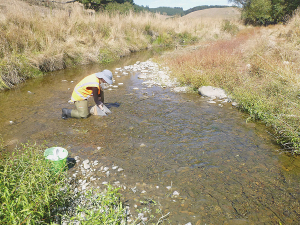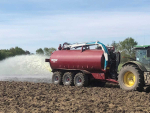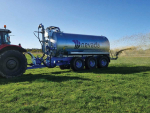The presence of koura (freshwater crayfish) in the Kakahu River, South Canterbury, was one of the highlights of eDNA monitoring and biomonitoring (periphyton, macroinvertebrates and fish) carried out in the Kakahu River in March 2024.
Opuha Water Ltd has just published its most recent quarterly water quality report which focuses on eDNA sampling and biomonitoring undertaken in the Kakahu River in January.
In the report, Opuha Freshwater Specialist Dr Jared Panther says the finding koura eDNA is significant as local anecdotal reports had suggested the threatened species was no longer present in the Kakahu.
“But it was found upstream and downstream of the Opuha Water discharge point into the Kakahu River, including upstream and downstream of the gorge. Kōura are more active at night and usually seek shelter from predators during the day, which is one reason why they are not easily observed in waterways during daylight hours.”
Panther says that eDNA for freshwater mussels, longfin eel, shortfin eel, upland bully, common bully, Canterbury galaxias, torrent fish and brown trout was also detected upstream and downstream of the discharge point.
Opuha Water publishes its quarterly water quality reports for Lake Opuha and the wider scheme catchment to share with the community the results of the company’s extensive water quality monitoring program.
Key findings of the March Kakahu River studies included:
eDNA monitoring
- Kōura, freshwater mussels, longfin eel, shortfin eel, upland bully, common bully, Canterbury galaxias, torrent fish and brown trout were all detected in the Kakahu River using eDNA.
- The ecological health of the Kakahu River was rated as either average or poor using the eDNA method.
Biomonitoring
- Macroinvertebrate community index (MCI) scores in the Kakahu River were similar to the eDNA findings, with waterway ratings of good and fair.
- The quantitative macroinvertebrate community index (QMCI) scores in the Kakahu River were higher upstream of the discharge point compared with downstream, with waterway ratings of good and fair.
- Longfin eel, shortfin eel, upland bully, common bully and trout were caught in the Kakahu River. These fish were identified upstream and downstream of the discharge point.
- SLR Consulting concluded that the collective biomonitoring results from the survey and previous surveys do not indicate any consistent patterns or significant adverse effects of the consented discharge on the freshwater communities of the Kakahu River.
Panther says the three main ecological aspects of the survey investigated to determine if a measurable impact of the discharge could be discerned were: periphyton (material that grows on the surface of rocks on the bottom of a stream or river which provide habitat and food source for macroinvertebrates), macroinvertebrates and fish.
 |
|---|
|
eDNA for species like longfin eel, was detected upstream and downstream of the discharge point.
|
“The levels of periphyton cover in the Kakahu River in March 2024 remained below guidelines set by the Ministry for the Environment and Environment Canterbury for thick mats and long filamentous algae.
“There was an increase in periphyton cover at the sampling site immediately downstream of the discharge point, relative to other sites, which could be due to a localised effect of the discharge but could also be due to other factors such as river works undertaken at the start of the irrigation season.
“However, there were no patterns evident in periphyton cover at the other downstream sites, which indicates there are no wider impacts of the discharge on the periphyton community.”
“Comparing the 2024 survey with the previous two surveys, there are no consistent patterns in macroinvertebrate community diversity, abundance or quality that would indicate any significant adverse effects of the discharge.
“Attributing a discharge effect is difficult, as different habitats in the Kakahu River will naturally give rise to different macroinvertebrate scores.
“High abundance and diversity of fish at sites downstream of the discharge indicate that the discharge is not adversely affecting the fish community.”



















